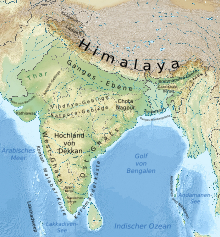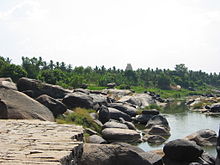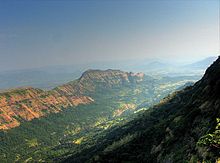Deccan Plateau
![]()
This article describes the landscape in South Asia; for the airline, see Simplifly Deccan.
Deccan or Dekhan, English also Deccan, (cf. Hindi दक्खिन dakkhin [ˈd̪ʌkːʰɪn], from Sanskrit दक्षिण dakṣiṇa [ˈd̪ʌkʂɪɳʌ], German 'south') is the name for the southern part of the Indian subcontinent, bounded on the north by the Indus-Gangetic Plain, on the west by the Arabian Sea, and on the east by the Bay of Bengal-two branches of the Indian Ocean-and extending south beyond Cape Comorin to the hill country of Sri Lanka.

Deccan Highlands
Geography
A distinction must be made between the entire Deccan and the highlands of Deccan. The plateau extends in the north to the countryside around the river Tapti and borders there on the mountain ranges of Satpura, in the west and east the mountain ranges of the Westghats and Eastghats form the boundaries, which almost collide in the south. It is a table-land, undulating in the east, flattening towards the west and forming extensive plains. The Deccan Trapp in the northwest is one of the largest basaltic areas on earth, covering about 500,000 km². In the west the heights of the Deccan Plateau are 1000 to 1300 m, in the center 500 to 600 m. The rivers originating in the Western Ghats flow through the plateau in an easterly direction and flow into the Bay of Bengal.
In addition to isolated areas of alluvial and diluvial soils, fertile black earth and laterite soils predominate. The Deccan Plateau is relatively dry because the southwest monsoon is held off by the Western Ghats. Agriculture is therefore dependent on irrigation.

At Hampi

Deccan Trapp in Maharashtra
Population
The predominant language groups are Marathi, Telugu and Kannada, small groups of the indigenous population of South India form the Bhil and Kol. The Muslim population, which is mainly located in the cities, mostly speaks Urdu.
Questions and Answers
Q: What is the Deccan Plateau?
A: The Deccan Plateau is a large plateau that covers most of South India. It extends over eight Indian states and covers 422,000 square kilometres (163,000 sq mi).
Q: What are the three mountain ranges surrounding the Deccan Plateau?
A: The three mountain ranges surrounding the Deccan Plateau are the Western Ghats in the west, Eastern Ghats in the east, and Satpura Range and Vindhya Range to its north.
Q: How much of India's landmass does it cover?
A: The Deccan Plateau covers 27.7 percent of India's landmass.
Q: How high is it above sea level?
A: In the south of India, it is mostly over 1,000 metres (3,300 ft) above sea level while in the north it is mostly about 500 metres (1,600 ft) above sea level.
Q: What type of habitats can be found on this plateau?
A: There are many different habitats on this plateau with different ecosystems containing different sorts of vegetation, climate, geology and animals.
Q: How old are these forests compared to other mountains in India?
A: These forests on this plateau are older than those found on Himalayan mountains.
Q: What shape does this triangle form when looking at a map?
A: When looking at a map from an aerial view or satellite image ,the uplands form a downward-pointing triangle within India's coastline.
Search within the encyclopedia